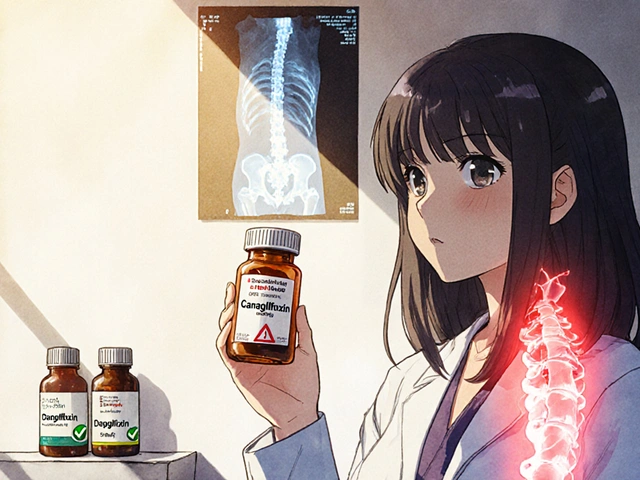Antipsychotic Medication Comparison Tool
Compare Your Options
Select your primary concern to see which antipsychotics might work best for you.
Results
Quick Summary
- Risperdal is effective for schizophrenia and bipolar mania but can cause weight gain and prolactin elevation.
- Aripiprazole, olanzapine, quetiapine, and ziprasidone are the most frequently considered alternatives.
- Key comparison factors include mechanism of action, approved uses, dosing simplicity, metabolic risk, and out‑of‑pocket cost.
- For patients sensitive to weight gain, ziprasidone or aripiprazole tend to be lighter on metabolism.
- Insurance formularies and generic availability often drive the final choice.
What Is Risperdal and When Is It Used?
When doctors prescribe Risperdal (risperidone), they are choosing a second‑generation (atypical) antipsychotic that blocks dopamine D2 receptors and serotonin 5‑HT2A receptors. This dual action helps reduce hallucinations, delusions, and mood swings. FDA‑approved indications include:
- Schizophrenia in adults and adolescents (13+)
- Bipolar I disorder - manic or mixed episodes
- Irritability associated with autistic disorder
Typical daily doses range from 1mg to 8mg, adjusted based on age, weight, and symptom severity. The drug is available as a tablet, orally disintegrating tablet, and a long‑acting injectable (Risperdal Consta).
How Risperdal Works - A Brief Pharmacology Snapshot
Risperidone’s high affinity for D2 receptors reduces psychotic signaling, while its 5‑HT2A blockade helps mitigate mood symptoms and some motor side effects common with older antipsychotics. However, its strong D2 binding also raises prolactin levels, leading to galactorrhea, menstrual irregularities, or sexual dysfunction in some patients.
Factors to Compare When Looking at Alternatives
Before jumping to a different medication, ask yourself (or your prescriber) these five questions:
- What is the primary symptom profile? - Is the focus on psychosis, mood stabilization, or both?
- How does the drug affect metabolism? - Weight gain, lipid changes, and glucose spikes are common concerns.
- What is the dosing convenience? - Daily pill versus weekly injection can matter for adherence.
- How affordable is it? - Generic availability, insurance tier, and pharmacy pricing all impact out‑of‑pocket cost.
- What side‑effect tolerability is needed? - Sedation, EPS (extrapyramidal symptoms), or prolactin rise may be deal‑breakers.
Answering these helps narrow the field to the drugs that truly fit the individual’s needs.
Side‑Effect Profile of Risperdal
Common adverse events reported in clinical trials and post‑marketing data include:
- Weight gain (average 2-4kg over 12weeks)
- Elevated prolactin - up to 30% of patients
- Somnolence or mild sedation
- Extrapyramidal symptoms (tremor, rigidity) - less frequent than first‑generation agents but still present
- Orthostatic hypotension (especially with the oral solution)
Serious but rare events are neutropenia and neuroleptic malignant syndrome.
Top Alternatives to Risperdal
Below are the most widely used atypical antipsychotics that clinicians consider when Risperdal isn’t the best fit.
- Aripiprazole (Abilify) - partial dopamine agonist, lower metabolic risk.
- Olanzapine (Zyprexa) - potent D2/5‑HT2 blockade, high efficacy but strong weight gain.
- Quetiapine (Seroquel) - sedating, useful for both psychosis and insomnia.
- Ziprasidone (Geodon) - minimal weight impact, requires food‑fasting for absorption.
- Haloperidol (Haldol) - first‑generation, higher EPS risk but inexpensive.
- Clozapine (Clozaril) - reserved for treatment‑resistant schizophrenia, requires blood monitoring.
Side‑By‑Side Comparison Table
| Drug | Mechanism | Approved Uses | Typical Daily Dose | Common Side Effects | Metabolic Impact | Approx. Cost* (USD/month) |
|---|---|---|---|---|---|---|
| Risperdal | D2 & 5‑HT2A antagonist | Schizophrenia, Bipolar I, Autism irritability | 1-8mg | Weight gain, prolactin ↑, mild EPS | Moderate (≈4kg gain/yr) | $35-$70 (generic) |
| Aripiprazole | Partial D2 agonist, 5‑HT1A agonist | Schizophrenia, Bipolar, Adjunct depression | 2-30mg | Akathisia, insomnia, nausea | Low (≈0.5kg gain/yr) | $25-$60 (generic) |
| Olanzapine | Strong D2 & 5‑HT2A antagonist | Schizophrenia, Bipolar I | 5-20mg | Weight gain, sedation, metabolic syndrome | High (≈7kg gain/yr) | $30-$80 (generic) |
| Quetiapine | D2 & 5‑HT2A antagonist, strong H1 block | Schizophrenia, Bipolar, Major depression adjunct | 150-800mg | Somnolence, orthostatic hypotension | Moderate (≈3kg gain/yr) | $20-$55 (generic) |
| Ziprasidone | D2 & 5‑HT2A antagonist, 5‑HT1A partial agonist | Schizophrenia, Bipolar I | 40-160mg (twice daily) | QTc prolongation, nausea, insomnia | Low (≈0.2kg gain/yr) | $45-$90 (brand only) |
| Haloperidol | Pure D2 antagonist (first‑gen) | Schizophrenia, Acute psychosis, Tourette | 0.5-20mg | Extrapyramidal symptoms, tardive dyskinesia | Low metabolic impact | $5-$15 (generic) |
| Clozapine | Multi‑receptor antagonist (D2, 5‑HT2A, α‑adrenergic) | Treatment‑resistant schizophrenia | 150-900mg | Agranulocytosis, seizures, weight gain | High (≈5kg gain/yr) | $80-$150 (brand + monitoring) |
*Cost estimates are for a typical U.S. pharmacy without insurance discounts; prices vary by region and insurance tier.
When Is an Alternative Preferable?
Risperdal alternatives become attractive in three common scenarios:
- Metabolic concerns. If a patient is already overweight or has diabetes, ziprasidone or aripiprazole usually cause the least additional weight.
- Prolactin‑related issues. Women with menstrual irregularities or men with sexual dysfunction may benefit from switching to a drug with weaker prolactin elevation (e.g., olanzapine or quetiapine).
- Adherence challenges. Long‑acting injectables like Risperdal Consta, or once‑daily options such as aripiprazole XR, can improve consistency when daily pills are missed.
Conversely, if a patient tolerates Risperdal well, the drug’s relatively low cost and broad indication coverage often keep it as the first choice.
Choosing the Right Medication - A Practical Checklist
- Identify primary symptoms. Psychosis‑dominant → consider high‑potency agents (risperidone, olanzapine). Mood‑dominant → aripiprazole or quetiapine may add mood stabilization.
- Assess metabolic baseline. Check BMI, fasting glucose, lipids before starting; choose low‑impact drugs if numbers are already elevated.
- Review side‑effect history. Prior EPS, prolactin issues, or QTc concerns narrow down options.
- Consider formulation. Oral daily vs. twice‑daily vs. monthly injection impacts adherence.
- Check insurance formulary. Some plans favor generic risperidone, others prefer brand‑only agents. Call the pharmacy to confirm copay.
- Plan for monitoring. Baseline labs (CBC for clozapine, fasting glucose for olanzapine) and follow‑up visits are essential.

Real‑World Example: Switching from Risperdal to Aripiprazole
Sarah, a 29‑year‑old with early‑onset schizophrenia, gained 6kg over six months on Risperdal 4mg daily. She also reported occasional breast tenderness. Her psychiatrist evaluated her metabolic labs (HbA1c 5.7%, LDL 130mg/dL) and decided to try aripiprazole 10mg daily.
After three months, Sarah’s weight stabilized, prolactin normalized, and psychotic symptoms remained controlled. The switch cost her a similar copay because both drugs are available as generics.
This case illustrates how a targeted change based on side‑effect profiling can improve quality of life without sacrificing efficacy.
Potential Pitfalls When Changing Antipsychotics
- Cross‑taper too quickly. Sudden discontinuation of risperidone can precipitate rebound psychosis. Aim for a 1‑2‑week overlap when possible.
- Ignore drug‑drug interactions. Some alternatives (e.g., ziprasidone) have CYP3A4 interactions; adjust doses if the patient is on antibiotics or antifungals.
- Overlook formulation differences. Switching from an oral tablet to a long‑acting injection requires a loading dose schedule.
- Neglect monitoring. New side effects (QTc prolongation with ziprasidone, agranulocytosis with clozapine) demand baseline ECG or CBC.
Frequently Asked Questions
Frequently Asked Questions
Can I switch from Risperdal to an over‑the‑counter supplement?
No. Antipsychotics work on specific brain receptors that supplements do not affect. Stopping risperidone without a medical plan can lead to relapse. Talk to a psychiatrist before trying any adjuncts.
Is the injectable form of Risperdal more effective than the tablet?
Effectiveness is similar; the main advantage is adherence. The monthly depot (Risperdal Consta) maintains steady blood levels and reduces missed doses.
What should I monitor if I start ziprasidone?
Get a baseline ECG to check QTc interval, especially if you have a personal or family history of heart rhythm issues. Also watch for nausea and ensure you take the dose with food.
Why does risperidone increase prolactin?
Risperidone blocks dopamine D2 receptors in the pituitary gland where dopamine normally suppresses prolactin release. When dopamine can’t bind, prolactin levels rise.
Are there any natural ways to lessen weight gain on antipsychotics?
Regular aerobic exercise, a balanced low‑glycemic diet, and sleeping at least 7 hours help. Some clinicians add metformin off‑label, but that must be prescribed.
Bottom Line
Risperdal remains a solid, cost‑effective option for many patients, but its side‑effect profile-especially weight gain and prolactin elevation-pushes clinicians to consider alternatives. By weighing mechanism, metabolic risk, dosing convenience, and price, you can find a medication that matches the clinical picture while reducing unwanted effects. Always involve a prescriber in any switch, and follow a gradual taper‑to‑new‑drug plan to keep symptoms under control.







Dorothy Anne
October 12, 2025 AT 23:13